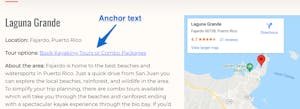- 10 minute read
- Digital Marketing
- SEO
- Websites
Link Building Tip: Use a Domain Authority Checker to Find the Best Sites
Intermediate,
Advanced
Join hundreds of other operators and REGISTER NOW for Spark 2024 New Orleans October 13-15th!

If you’ve spent some time perusing FareHarbor Compass, you’ve likely noticed us using anchor text. Anchor text is the text used in a link. It might say “learn more,” “our favorite kayak routes,” or “find more content marketing resources.” Anchor text is clickable, taking users to another page or website.
Beyond making it easy to direct readers to another page, Google also uses anchor text to understand what a page is about. Additionally, using anchor text is extremely helpful in link building. While you shouldn’t overuse anchor text, there are a few best practices and guidelines on how to best use it. Reference this guide next time you want to spice up a blog post or other piece of content with a few links.
 The Link Between Anchor Text & SEO
The Link Between Anchor Text & SEOWhen it comes to choosing anchor text, there’s overlap between what best serves search engines and what best serves users. As a general rule of thumb, anchor text should always tell a user what they can expect when they click on a link. In the above example about content marketing resources, you probably expected to find a list of articles covering that topic, and that’s exactly what you got!
Anchor text has a big impact on SEO. Search engines use link relevancy – how well the topic of page A relates to linked page B – as a metric for determining rankings. If the link is highly relevant, it often improves the ranking of both page A and page B for queries related to the topic. Link relevancy is not only determined by the topic of the source page (page A), but also the content of the anchor text on that source page. That’s why generic anchor text like “click here” doesn’t serve its full purpose in terms of SEO.
You might be wondering how to optimize anchor text for SEO. Like most SEO content writing, it’s best to use descriptive keywords that accurately describe the page you’re linking to. However, it’s important not to engage in keyword stuffing – the obvious overuse of keywords – or use an excessive amount of anchor text on a page. While there’s no right or wrong number of links, you can typically find that sweet spot by reading the page content and asking yourself if it sounds and looks natural.

 Best Practices for Using Anchor Text
Best Practices for Using Anchor TextUnderstanding how anchor text affects SEO will help you create stronger anchor text. Keep these best practices in mind when adding links to your content.
Now that you know the best ways to use anchor text, you can play around with links to enhance user experience on your website. Remember, anchor text is an essential part of link building, so be sure to brush up on outreach and see where you can improve your existing anchor text.